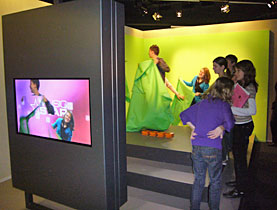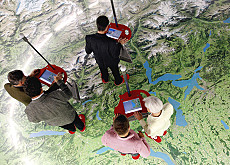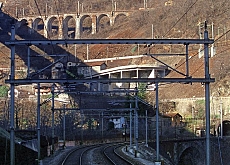Transport museum moves forward

Switzerland's popular national transport museum in Lucerne is undergoing a complete renovation after half a century of service.
One of the improvements is an upgraded media workshop that takes into account some of the latest technological developments.
It’s not just planes and trains that are on display at the museum on the shores of Lake Lucerne. Pressing buttons, turning wheels and understanding technical processes have long been part and parcel of the fascination for younger and older visitors.
With the upgrade, the popular destination is moving on. “We want to change into a theme park about mobility rather just operate as a museum,” its president Franz Steinegger told swissinfo.
One sign of this change is the construction of the Media Factory in collaboration with the Swiss Broadcasting Corporation, swissinfo’s parent company. Visitors can produce their own radio and television shows, record them, and take or send a copy home or to the classroom via internet.
The studios and their digital network replaced older technology and reflect current trends.
“Youngsters can pretend to be presenters, or produce a broadcast of a football match or a pop concert,” explains the head of the exhibit, Daniel Schlup. “That way they can understand that a television screen doesn’t give a complete view of the world.”
Open-air arena
The renovation of the museum should be completed by next summer, in time for the 50th anniversary. The plans for the upgrade were approved in 1999, and included the demolition of some exhibition halls to increase the size of the inner courtyard, transforming into an open-air arena.
This space will be used for special exhibitions according to the museum’s director, Daniel Suter.
“You will be able to land six helicopters in the yard,” he said. “There will also enough room to put a ship on show, or 450 cars.”
When the arena is opened to the public in June, a new exhibition hall built along the lines of an indoor parking lot or a garage and focusing on road transport will also begin operating. Vehicles will be placed on racks and automatically brought in front of visitors at the press of a button.
“There will be nothing like it anywhere in the world,” Suter told swissinfo. “Visitors will be able to decide which vehicle they want to look at.”
The new glass-walled reception area is already complete. Depending on the light and time of day, the façade changes colour and its appearance.
Renovation work in other parts of the museum has also been completed. The aviation and space building as well the one devoted to shipping have already had a makeover.
Train stop
The railway building, which houses a substantial collection of old locomotives and wagons, was revamped in time for the 100th anniversary of the Gotthard tunnel line in 2007, when the museum also received its own regional train stop.
Suter reckons it is all money well spent. He estimates that each Swiss visits the museum three times on average in his or her lifetime – once as a student, once as a parent and once finally as a grandparent.
The director hopes that figure will increase thanks to special exhibitions and a regular turnover of the items on display in the regular exhibitions.
So far, the museum has normally covered its running costs through ticket sales.
“We are proud of that fact,” said Steinegger. “We are the cheapest member of the national museums’ group.”
“Public funds are used for our museum tasks such as maintaining our collections and keeping an inventory,” he added.
swissinfo, Andreas Keiser
The Swiss national transport and communication museum opened on July 1, 1959 with the backing of the Swiss Federal Railways and the Swiss Post.
Since its opening, it has been the most visited museum in Switzerland. Around 875,000 people passed through its doors in 2007.
Approximately 60,000 schoolchildren made the trip to Lucerne last year as part of a class trip.
In 1992, the museum recorded its lowest visitor figures with only 530,000 people passing through the gates. Since then, it has organised regular special exhibits and in 1996, an IMAX theatre was opened.

In compliance with the JTI standards
More: SWI swissinfo.ch certified by the Journalism Trust Initiative


You can find an overview of ongoing debates with our journalists here . Please join us!
If you want to start a conversation about a topic raised in this article or want to report factual errors, email us at english@swissinfo.ch.